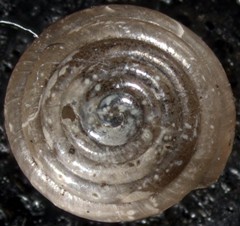
Classification

Domain:Eukaryota
Kingdom:Animalia
Phylum:Mollusca
Class:Gastropoda(Cuvier 1797)
Order:Stylommatophora
Family:Helicarionidae
Genus:Euconulus(Reinhardt 1883)
Species:Euconulus polygyratus(Pilsbry 1899)
Clarification on taxon classifications:
Domain Eukaryota would include organisms whose cells contain a true nucleus. Domain Eukaryota is one of the three domain-systems of biological classification introduced by Carl Woese in 1990. The other two domain- systems of classification are Archae and Bacteria.
Kingdom Animalia classification would require an organism to be eukaryotic, as well as posses several characteristics that would distinguish them from other living things. Some of the characteristics include, but are not limited to, being multicellular, heterotrophic, possessing sensory organs and having the ability to move voluntarily.
Phylum Mollusca includes organisms as diverse as chitons, snails, clams, and octopuses. They range from fairly simple organisms to some of the most complex invertebrates, and from microscopic in size to giant squid. The name mollusca, comes from the Latin word molluscus, meaning "soft", indicating one of their distinctive characteristics, a soft body (Eisenhour et al. 2007).
Class Gastropoda(Cuvier 1797)(Gr. gastér, stomach, +pous, podos, foot) is by far the largest and most diverse. Its members differ so widely that no single general term in our language can apply to them as a group (Eisenhour et al. 2007). Gastropoda or gastropods are more commonly known as snails and slugs, which concurs with the Greek meaning of the name(broken down and listed above), considering most snails and slugs have a complex digestive system, as well as a ventral foot that may be adapted for locomotion, attachment to substrate, or for a combination of functions (Eisenhour et al. 2007).
Order Stylommatophora is of air-breathing land snails and slugs, terrestrial pulmonate gastropod molluscs. This taxon includes a majority of the land snails and slugs.
Family Helicarionidae is of air-breathing land snails or semi-slugs, terrestrial pulmonate gastropod molluscs in the order Stylommatophora.The snails in this family have shells that are shaped like hives.
Genus Euconulus (Reinhardt 1883) are known as the "hive snails", due to their conical shaped shell, that resembles a hive. Hive snails recycle! Hive snails have a groove at the end of their foot, where the mucus they crawl on is collected in a clot, to be recycled back into the body(molluscs.at).
Species Euconulus polygyratus(Pilsbry 1899) denotes the genus name(Euconulus) followed by the specific epithet (polygyratus) which is a name that is unique and designated for this specific organism. For a thorough description of appearance factors that distinguish Euconulus polygyratus from other species, you can click on the gallery link, listed on the left side of this page.